Control of Gene Expression in Prokaryotes
1/50
There's no tags or description
Looks like no tags are added yet.
Name | Mastery | Learn | Test | Matching | Spaced |
|---|
No study sessions yet.
51 Terms
The promoters of both bacterial and eukaryotic genes include what two components?
An initiation site
Regulatory DNA sequences (switch the gene on or off)

T/F: Regulatory DNA sequences work by themselves.
False. To have any effect, these sequences must be recognized by proteins called transcription factors (regulators), which bind to the DNA and recruit RNA polymerase OR inhibit its binding.
A few protein arrangements are used in thousands of different regulatory proteins and are called _____. What are some examples?
motifs. Helix-turn-helix (HTH), zinc fingers, and leucine zippers.

What helix-turn-helix domains are in eukaryotes? What DNA sequences do they recognize? Is the structure conserved?
Eukaryotes call them homeodomain (HD) proteins, which are 60-amino acid HTH structure and are very highly conserved. They often recognize asymmetric DNA sequences.
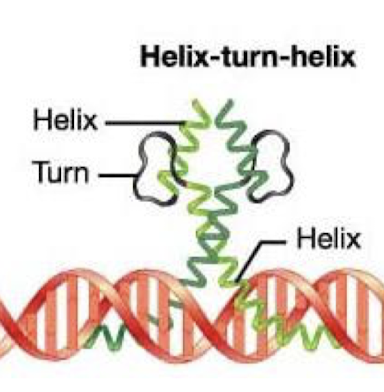
How does the helix-turn-helix binding motif contact DNA?
The N-terminal tail contacts the DNA minor groove, and the alpha-helix (recognition helix) is inserted into the major groove.
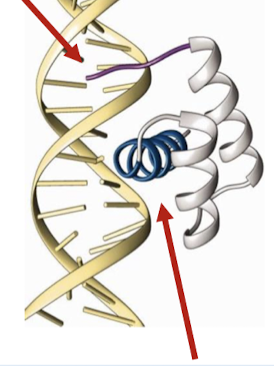
Which of the proteins involved in prokaryotic transcriptional regulation contain a helix-turn-helix motif?
Lac repressor, CAP, trp repressor
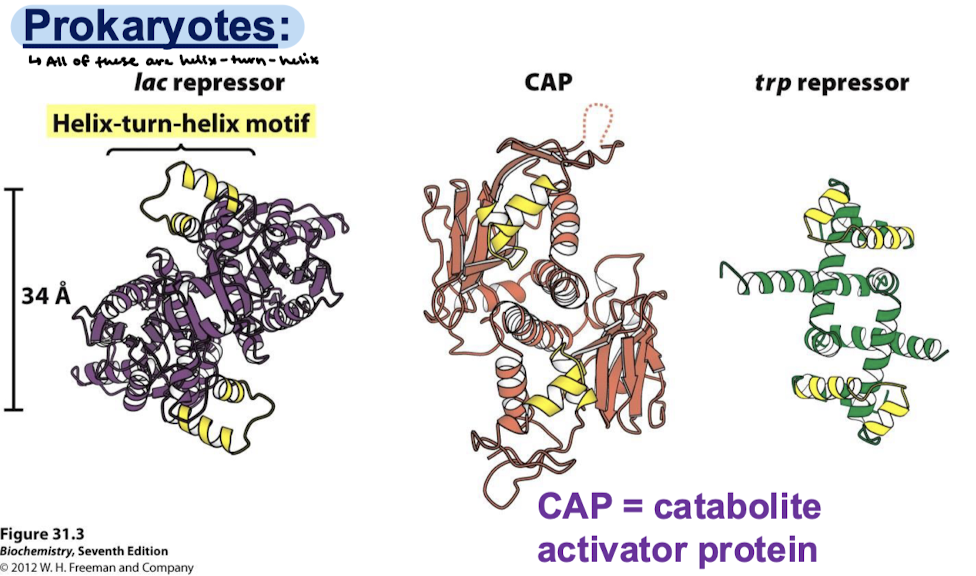
What are the two categories of transcription regulation in bacteria?
Use of sigma factors
Binding other proteins (DNA-binding proteins) to regulatory sites
Describe how sigma factors can regulate transcription. What is an example?
They recognize different classes of promoters and allow coordinated expression of different sets of genes. For example, sigma 32 regulates heat shock genes in E. coli, while sigma 70 regulates many E. coli promoters in normal conditions.

What sites do DNA-binding proteins involved in regulation recognize? What does this allow for?
Recognize and bind regulatory sites in the promoters of specific genes. These may bind small signaling molecules. Binding allows for expression of specific genes in response to signals in the enviornment.
What is an operon?
A cluster of functionally related genes under coordinated control by a single on-off “switch”

Would each gene in the lac operon have a Shine-Dalgarno sequence and AUG?
Yes because the ribosome needs a binding site for each gene.

What is the regulatory “switch” of the operon? What is this in the Lac operon?
The operator (usually positioned within the promoter). In the case of the lac operon, the repressor prevents gene transcription by binding to the operator and blocking RNA polymerase.

Transcription of operons is controlled by _______ and ________.
induction and repression
What is positive regulation of gene expression?
The activator protein(s) must bind to the regulatory DNA as a prerequisite to turn the gene on.
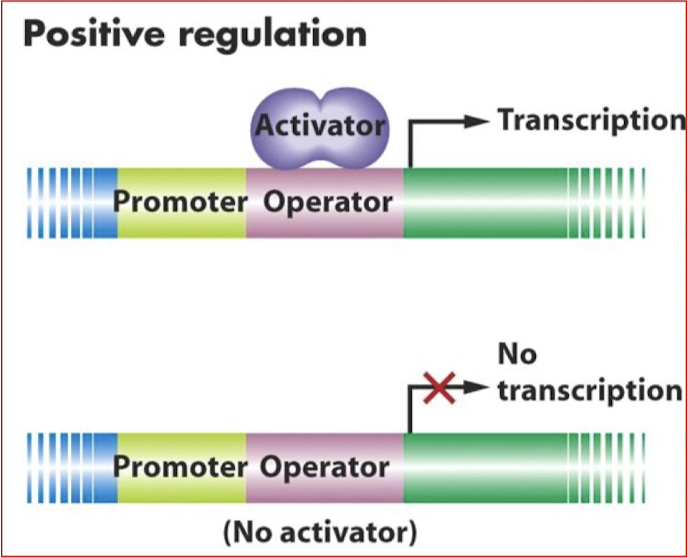
What is negative regulation of gene expression?
A repressor protein must bind to the regulatory DNA as a prerequisite to stop gene expression.
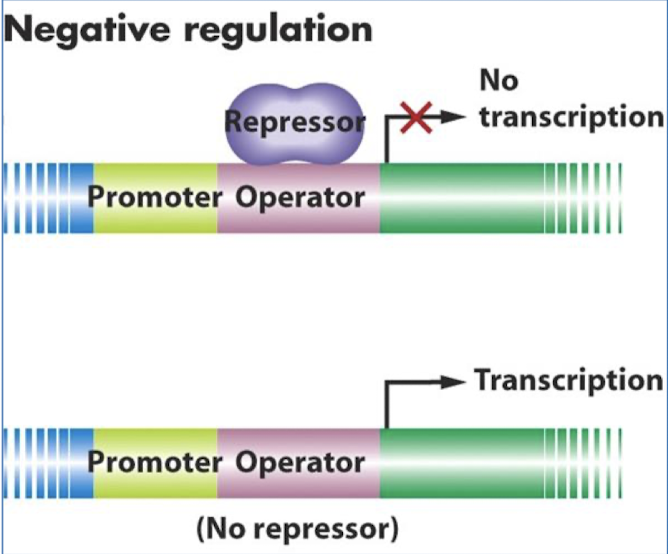
The molecules that cause the allosteric modification are called…
allosteric effector molecules
What two states can the activator and repressor exist in? What is the purpose of allosteric effectors?
The activator and repressor proteins exist in two states depending on whether they are bound or not bound with a certain molecule. The activator or repressor protein undergoes allosteric change when it binds with a specific molecule (conformational change). Allosteric modification increases or decreases DNA binding affinity property of the activator or repressor protein, respectively.
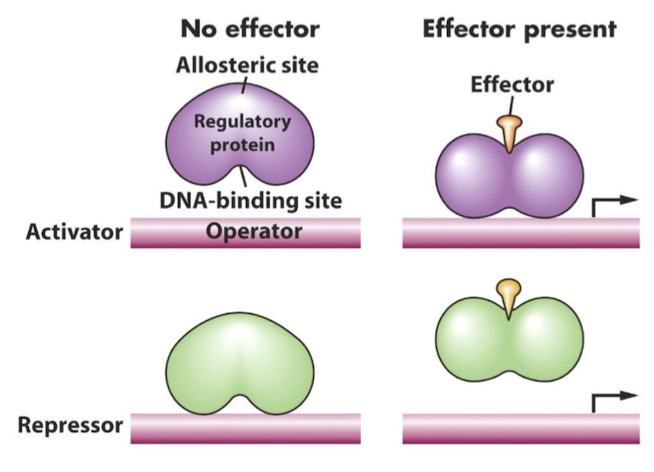
What does a graph of beta-galactosidase in ug versus total bacterial protein in ug look like in the absence of glucose and with the lactose added?
Linear increase then a plateau as lactose is removed. When grown in the presence of glucose or glycerol, bacteria have only about 10 molecules of beta-gal. In the presence of lactose only, beta-gal level goes up several thousand fold.
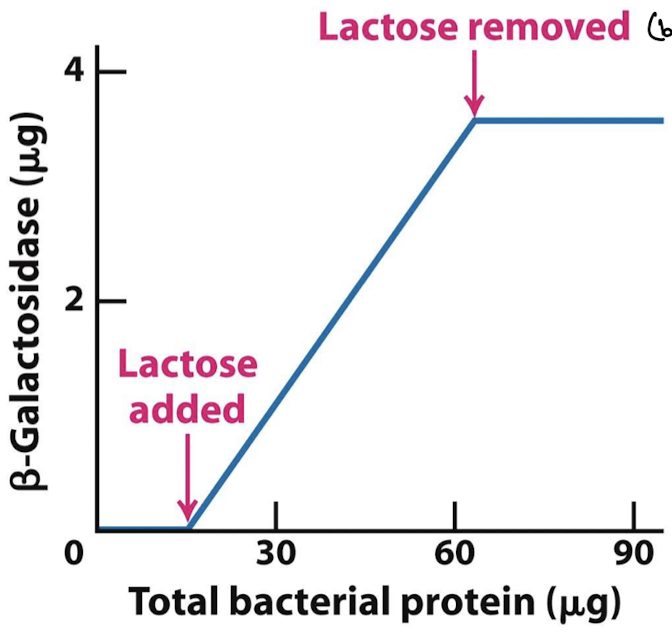
What kind of symmetry does the lac operator have?
Two-fold rotational symmetry
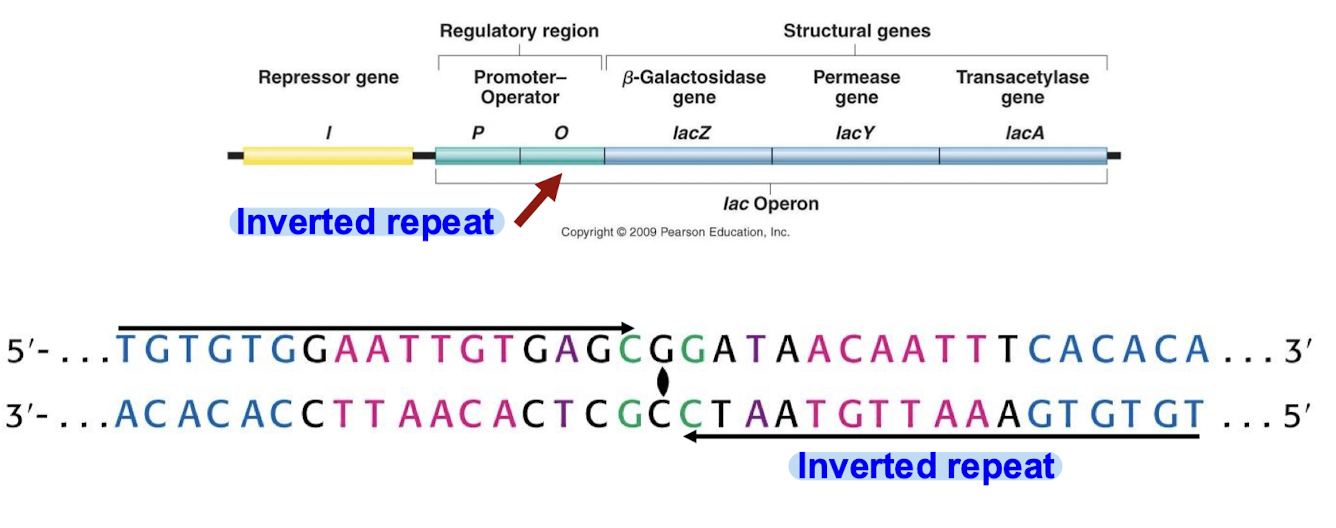
How many operator sites are there in the lac operon? What are they for?
O1 is the primary operator site, and O2 and O3 are the auxiliary operator sites. O3 is the operator site where the activator binds because it is near the CAP binding site. O1 is where the lac repressor binds because it is near the RNAP binding site. O1 is necessary for protein synthesis, but O2 and O3 are not necessary because proteins are still synthesized without them.
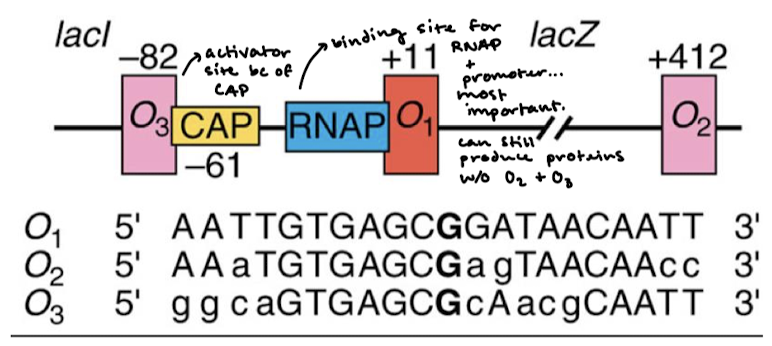
Why is the CAP binding site near the RNAP binding site? Why is the O1 location important?
So it can help recruit RNAP. Lac repressor binding to the O1 operator blocks the +1 site and prevents RNAP from initiating transcription.
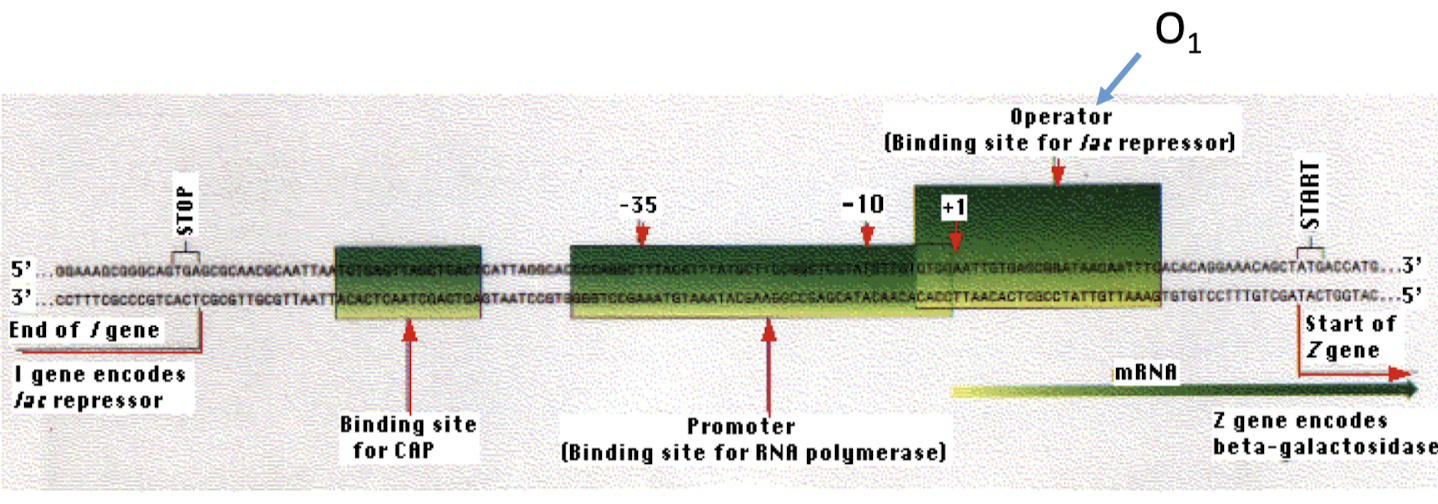
What to Lac Z, LacY, and Lac A encode for and what are the functions of those proteins?
LacZ → beta-galactosidase (cleaves lactose to glucose and galactose and isomerizes lactose into allolactose)
LacY —> lactose permease (channel protein for lactose entry)
LacA —> galactoside O-acetyltransferase (detoxifies certain other things that enter the cell through LacY)
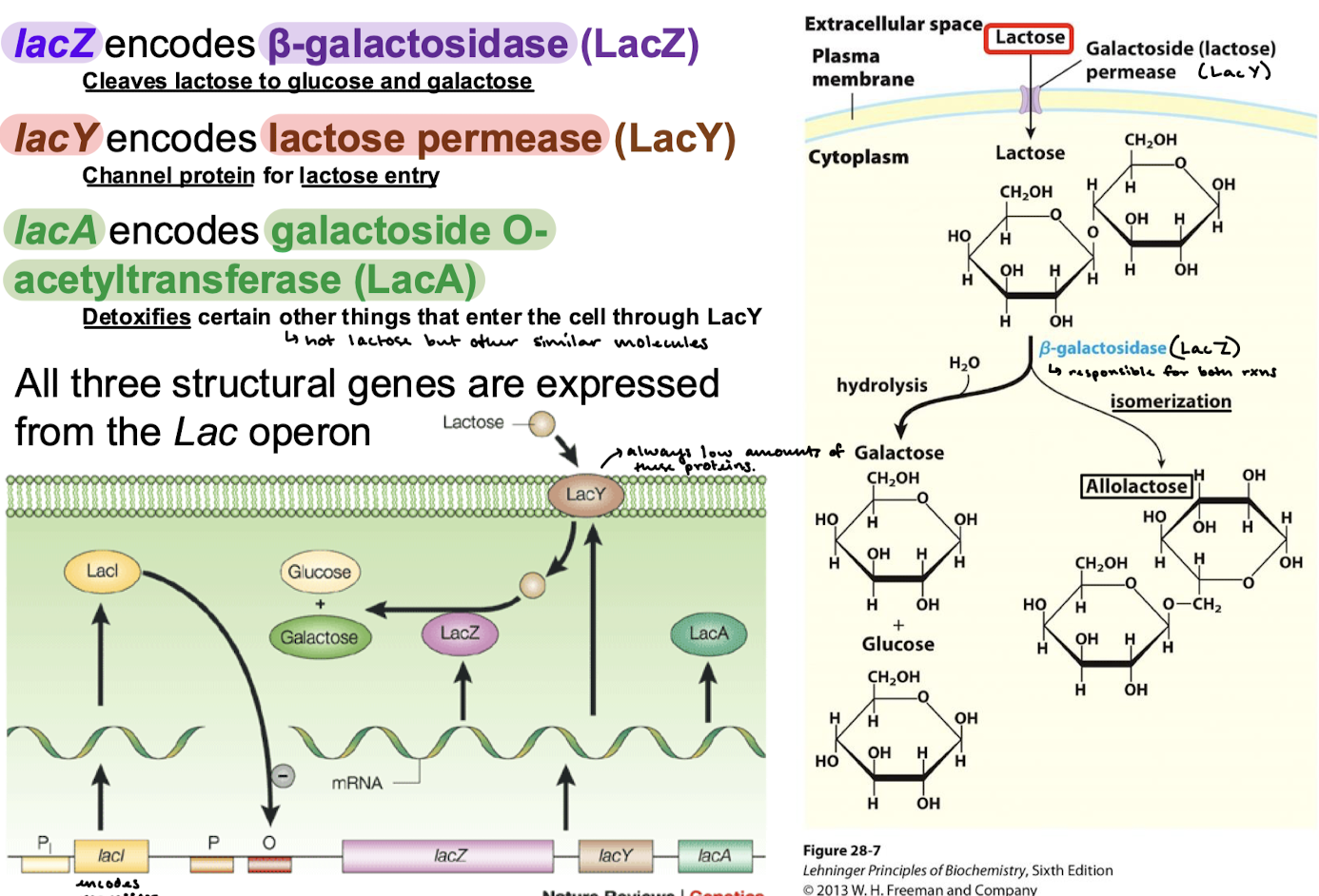
Wha tis the main source of carbon and energy in bacteria?
Glucose
What does the lac operon look like in the absence of lactose?
The repressor is expressed and will bind the operator. RNAP binding is inhibited and transcription is repressed.

What does the lac operon look like in the presence of lactose?
Allolactose (inducer) binds the repressor and induces a conformational change that causes inability to bind the operator. RNA polymerase can bind the promoter and transcription ensues.

What is the natural inducer of the lac operon? What is its function?
1,6-allolactose binds to the repressor and causes it to dissociate from the operator.
What is the synthetic, non-metabolizable inducer of the lac operon? What is its function?
IPTG (isopropylthiogalactoside) binds to the repressor and causes it to dissociate from the operator. IPTG cannot be digested and is very stable, but can still leave the operator.
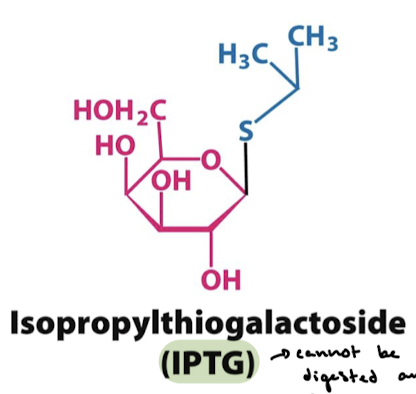
How does inducer binding cause repressor to leave the operator?
Binding induces conformational change in the repressor, which greatly reduces the affinity of the repressor to bind the operator DNA.
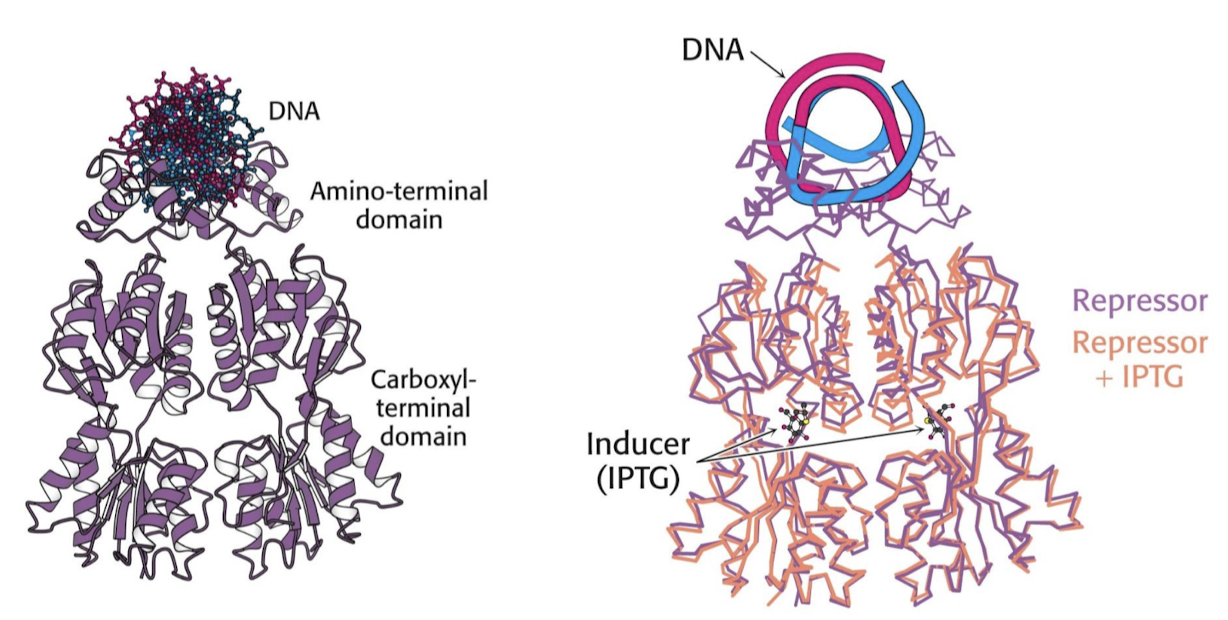
How does the lac repressor bind operator DNA to form a complex (what does the interaction look like)?
Sequence-specific binding due to specific contacts between the recognition helix of the HTH and the major groove. The hinges are in the minor groove.
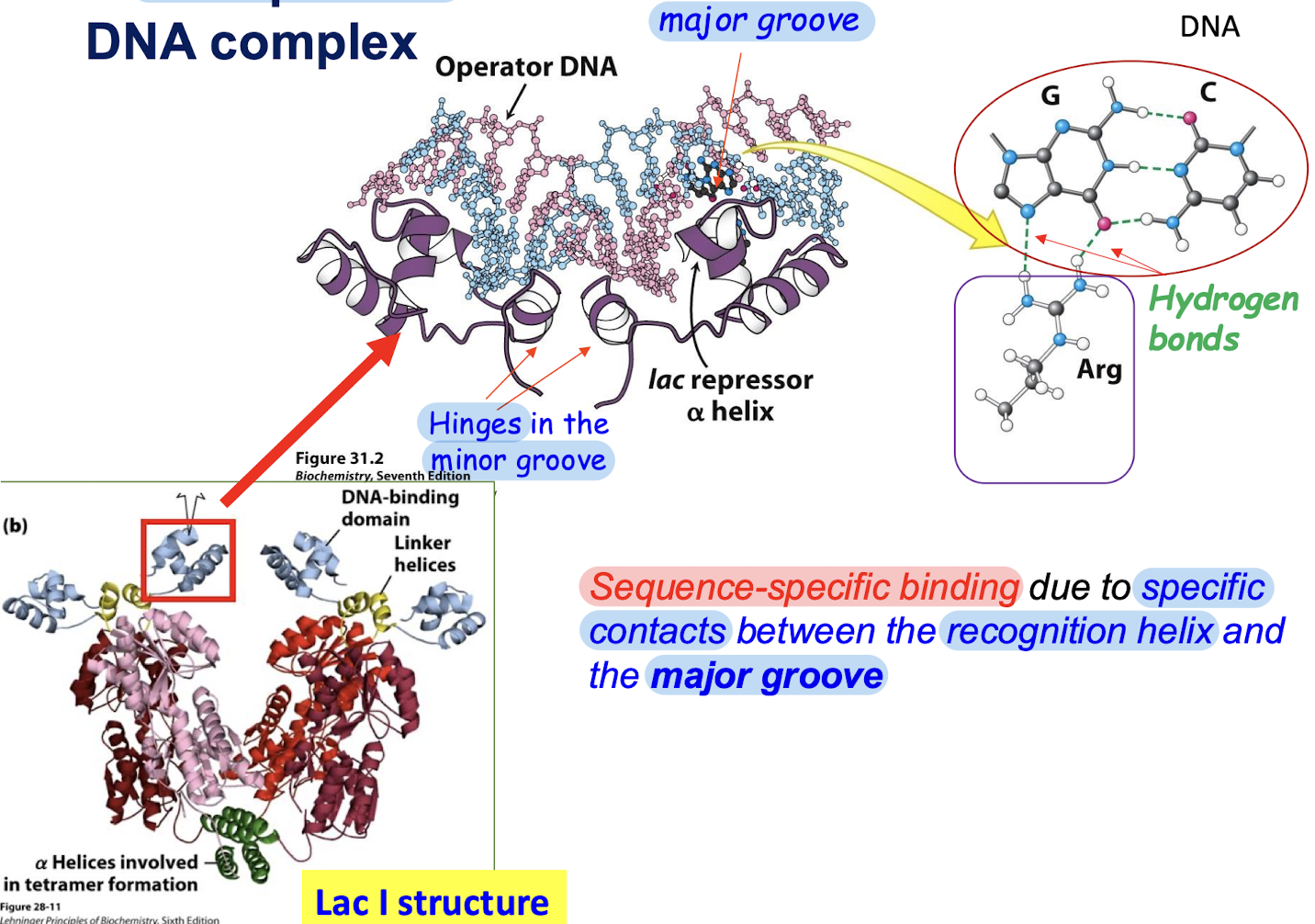
How are the promoter and start site sequestered to inhibit transcription of the lac operon?
Binding of the lac repressor induces a bending in the DNA that sequesters the -35, -10, and +1 sites (promoter and start of transcription site). Alpha helices form upon DNA binding and insert into the minor groove, inducing bending of the DNA.
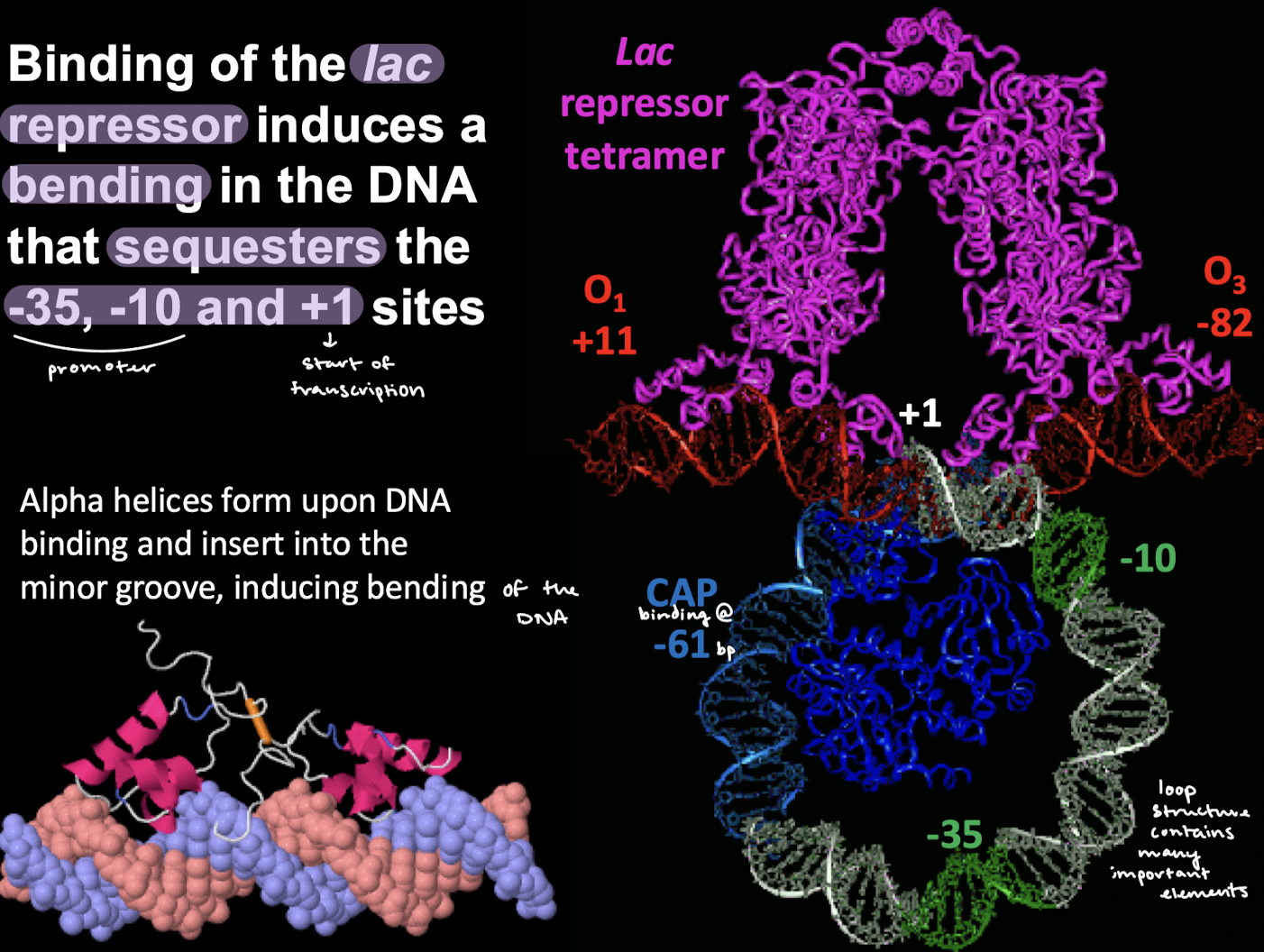
The lac operon is regulated _______ (repressor) and ________ (CAP), and both operate _________. What is the analogy for this?
Negatively, positively, and independently. It is like opening a door because that requires unlocking the door (negative control undone) and turning the knob (positive control).

What is catabolite repression of the lac operon?
When the availability of glucose governs expression of lactose-digesting genes. When glucose is present, there are low levels of cAMP, and lactose genes are turned off.
What is the structure of CAP-cAMP complex?
A homodimer.
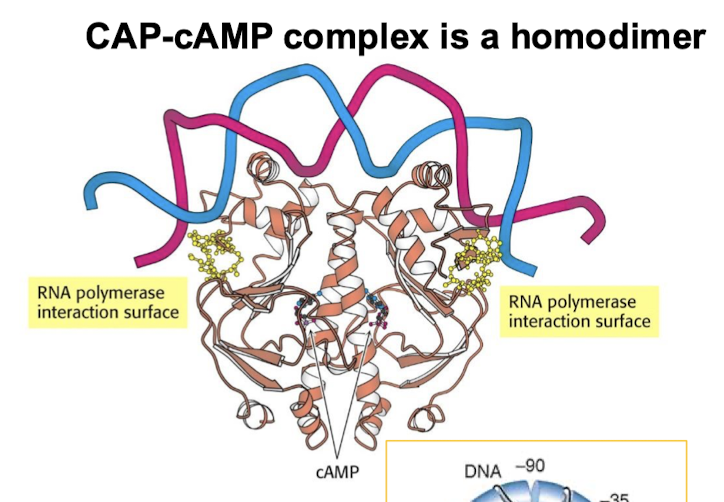
How effective is CAP-cAMP binding? How does it work and when does it work?
CAP-cAMP binding stimulates transcription 50-fold. It bends DNA and the open complex will not form readily without this. CAP-cAMP only has this effect when the Lac repressor has dissociated.
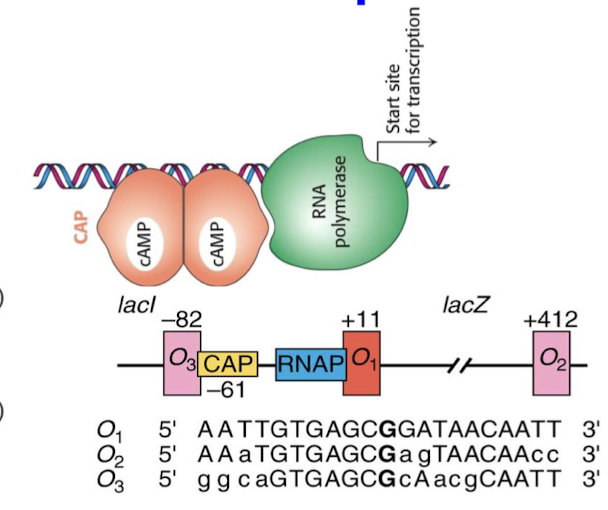
What makes cAMP and when? What does CAP stand for?
cAMP is made by adenylate cyclase when glucose concentration is low. CAP = catabolite activator protein (also known as CRP)
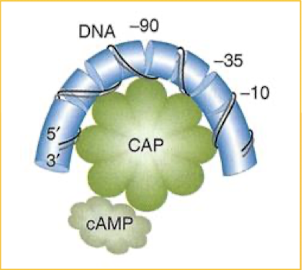
Why are cAMP levels low when glucose is present?
Glucose inhibits the formation of cAMP by inhibiting the enzyme adenylyl cyclase. Glucose DOES NOT bind to a regulatory protein.
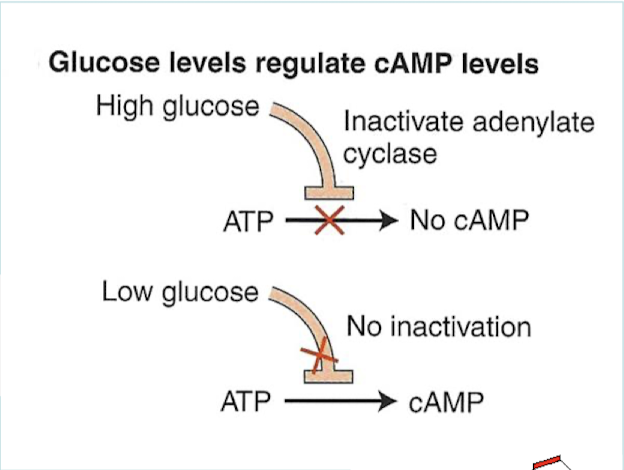
Describe each situation below:
Glucose and lactose present
Glucose present and lactose absent
Glucose and lactose absent
Glucose absent and lactose present
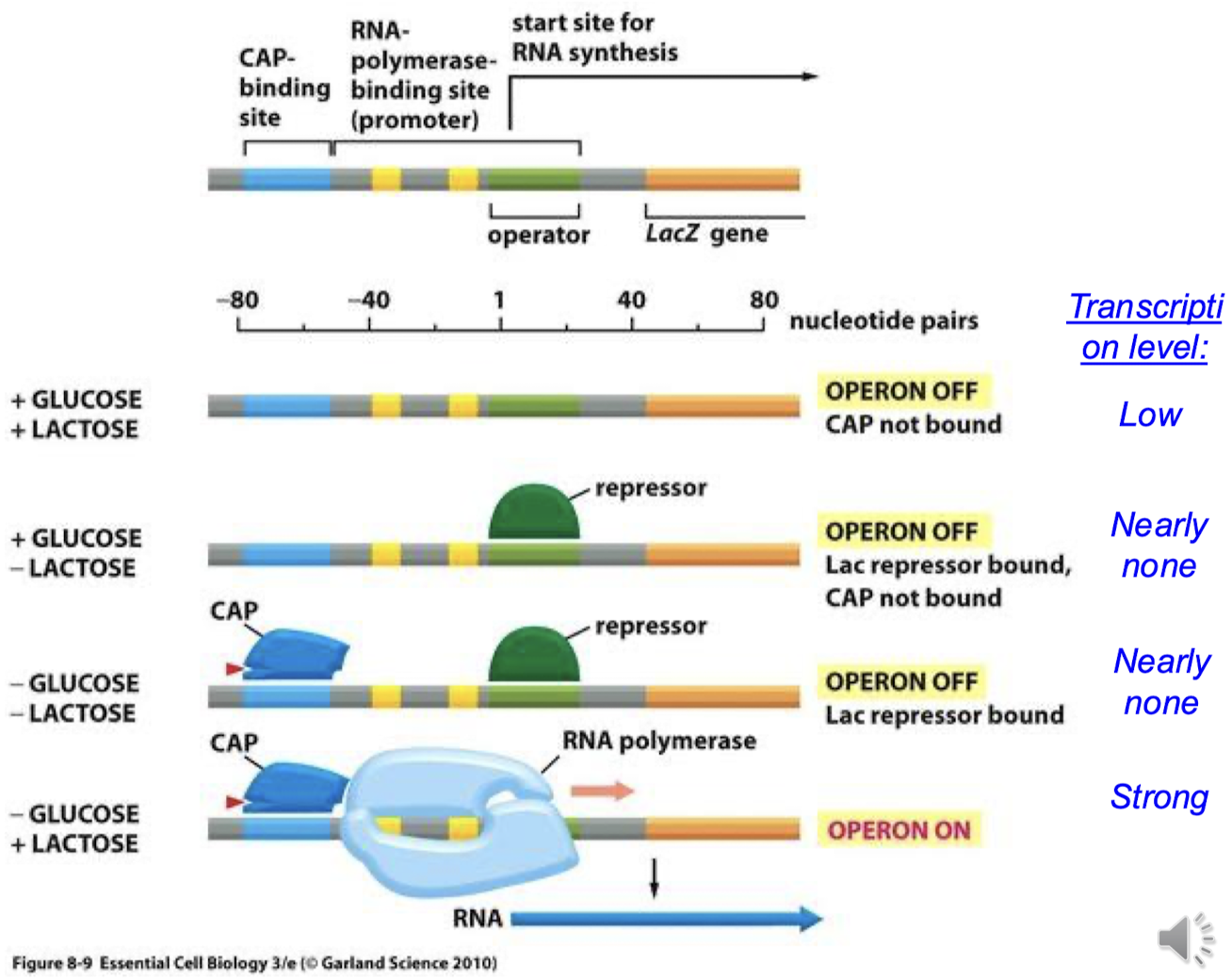
What is X-gal? Why is it important?
X-gal is an analog of lactose and is a colorless pigment. When beta-galactosidase is present, the beta-glycosidic bond is cleaved. That product is then spontaneously dimerized and oxidized, producing a blue colored pigment. In gene cloning, X-gal is used as a visual indication of whether a cell expresses a functional beta-galactosidase enzyme. Therefore, lacZ gene is used as a reporter gene.
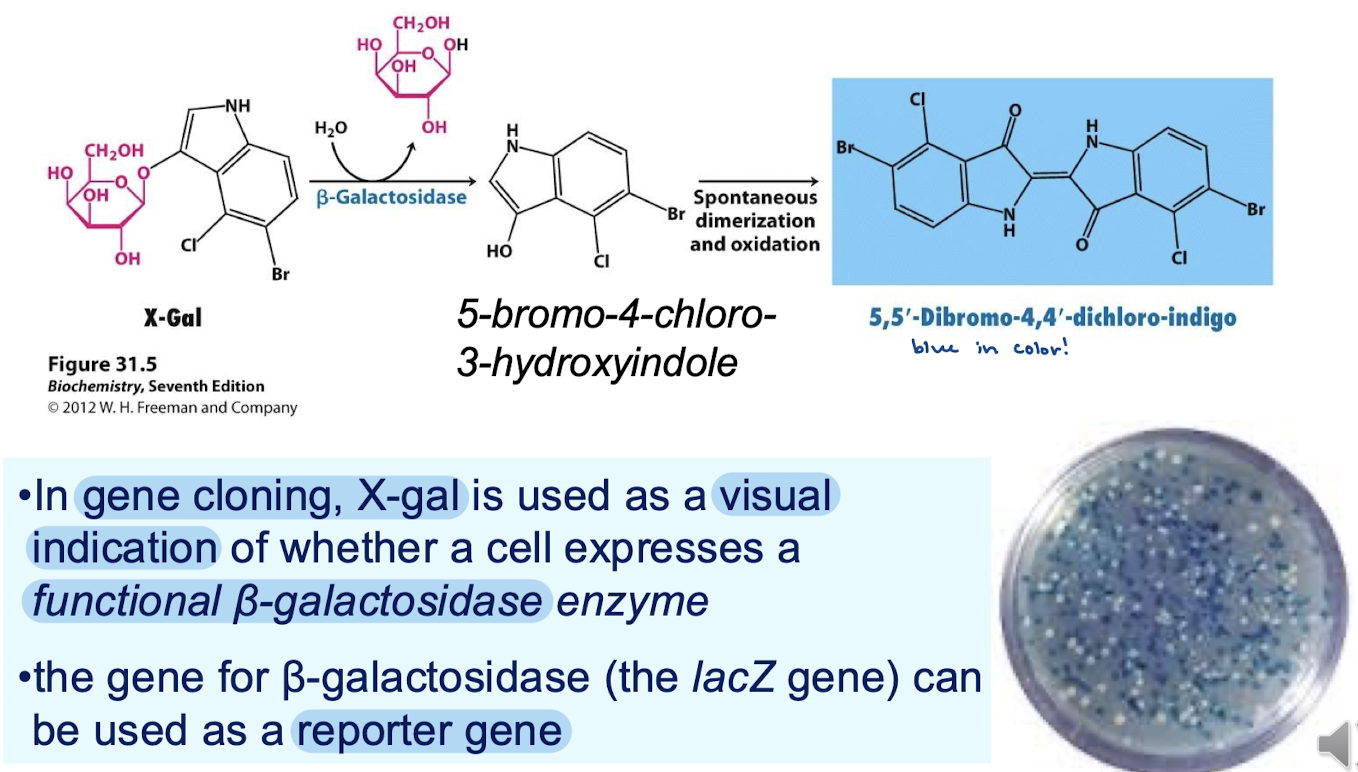
How many structural genes are in the trp operon, and what are their functions? What are the two methods of inhibition?
Trp operon encodes 5 enzymes that convert chorismate into Trp.
The trpR repressor decreases gene expression by altering the initiation of transcription (intracellular [Trp])
Attenuation: responds to the concentration of charged tRNAtrp (post-transcriptional)
Explain how the repressor represses the trp operon. What are the possible mRNA products in attenuation and in what conditions?
The trp repressor is expressed by the trpR gene. Trp binds the repressor and induces a conformational change that gives the repressor a higher affinity for the operator. Binding to the operator represses transcription. Attenuation in the trpL can result in attenuated mRNA in conditions of high intracellular [Trp] and the full trp mRNA (with all structural genes) in conditions of low intracellular [Trp].
![<p>The trp repressor is expressed by the trpR gene. Trp binds the repressor and induces a conformational change that gives the repressor a higher affinity for the operator. Binding to the operator represses transcription. Attenuation in the trpL can result in attenuated mRNA in conditions of high intracellular [Trp] and the full trp mRNA (with all structural genes) in conditions of low intracellular [Trp].</p>](https://knowt-user-attachments.s3.amazonaws.com/2a10fd63-2e55-4c96-9592-43c9c919ce1c.png)
Describe the role of the leader sequence, its structure, and when it is transcribed.
The leader region at the 5’ end is transcribed first, and translation initiates within this region before the DNA polymerase begins to transcribe the five structural genes encoding the five enzymes needed to synthesize tryptophan. There are four regions within the leader that, when transcribed into mRNA, can participate in stem-loop structures for regulation by attenuation.

The regulation of the trp operon by attenuation is ____________.
co-transcriptional
What is the first attenuation that is done before both pathways of attenuation regulation? Describe what happens here for both pathways.
The pause attenuation loop is between regions one and two. It stalls the RNAP so the ribosome can catch up because the ribosome needs to be close for co-transcriptional regulation.

Describe what happens in attenuation regulation of the trp operon when there are low levels of trp in the cell.
Low concentration of Trp means low concentrations of charged Trp tRNAs. The ribosome is going to incorporate these Trp amino acids into the growing polypeptide chain due to the low concentration of Trp charged tRNAs, so the ribosome will stall when it reaches these codons. The anti-termination stem loop is able to form between regions two and three, and RNAP will keep transcribing the entirety of the mRNA. This will allow for the ribosome to express all five enzymes in the operon and the leader peptide will also be translated.
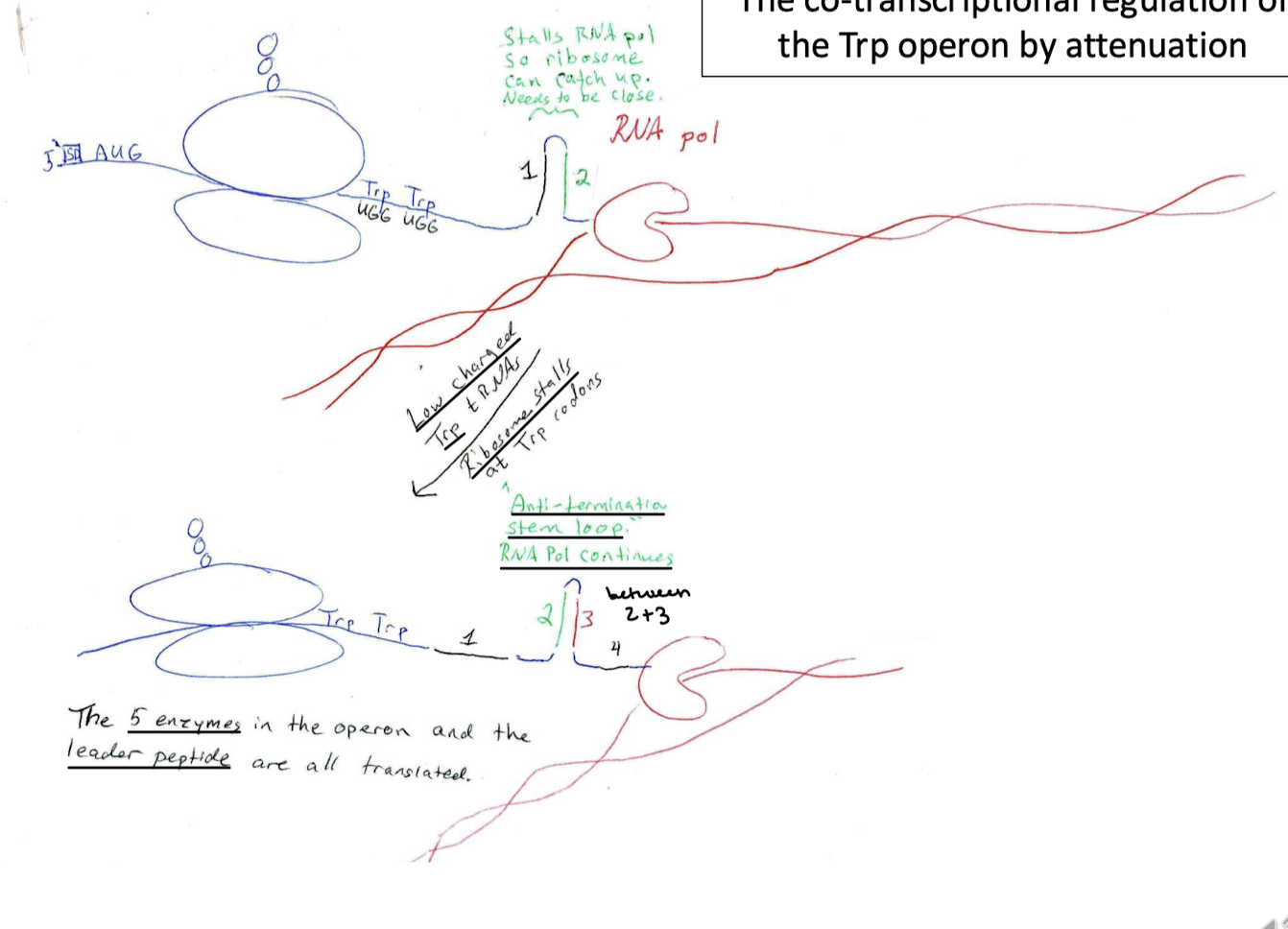
Describe what happens in attenuation regulation of the trp operon when there are high levels of trp in the cell.
High concentrations of Trp in the cell mean high concentrations of Trp charged tRNA in the cell. The ribosome will not stall at the Trp codons ahead of the first region because it will easily incorporate Trp into the nascent chain. Regions 3+4 will form the attenuator stem loop for termination of transcription. RNAP will terminate transcription and dissociate at the series of uracils following the stem loop. Only the leader peptide is translated due to premature transcriptional termination.
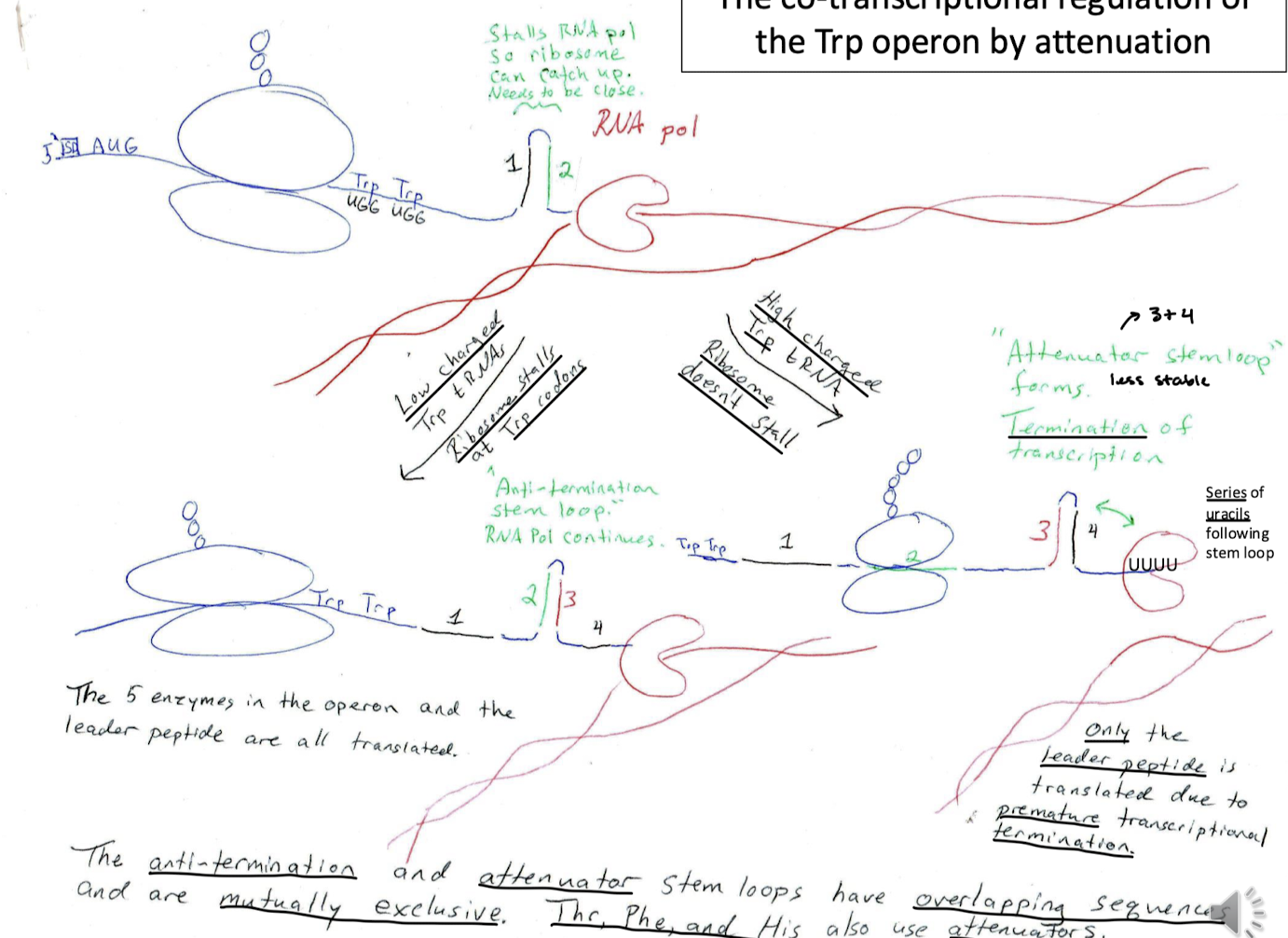
Can the anti-termination and termination attenuation stem loops occur at the same time?
The anti-termination and attenuator stem loops have overlapping sequences and are mutually exclusive. Thr, Phe, and His also use attenuators.
If there is insufficient intracellular concentration of the amino acid, then transcription…
is allowed to continue through the leader sequence.
If there are sufficient intracellular concentrations, transcription…
terminates within the leader sequence.
What is the purpose of leader regions containing several codons for a particular amino acid?
The concentration of that amino acid can be sensed based on the speed of translation through this region.
Transcription and translation must be tightly coupled in the trp operon. What helps keep transcription and translation close together?
The stem loop between regions 1 and 2 helps keep them close together.
What other amino acids have leader sequences that undergo attenuation?
Thr, Phe, and His
